-
Fun & Fabulous Fall Porch Decor
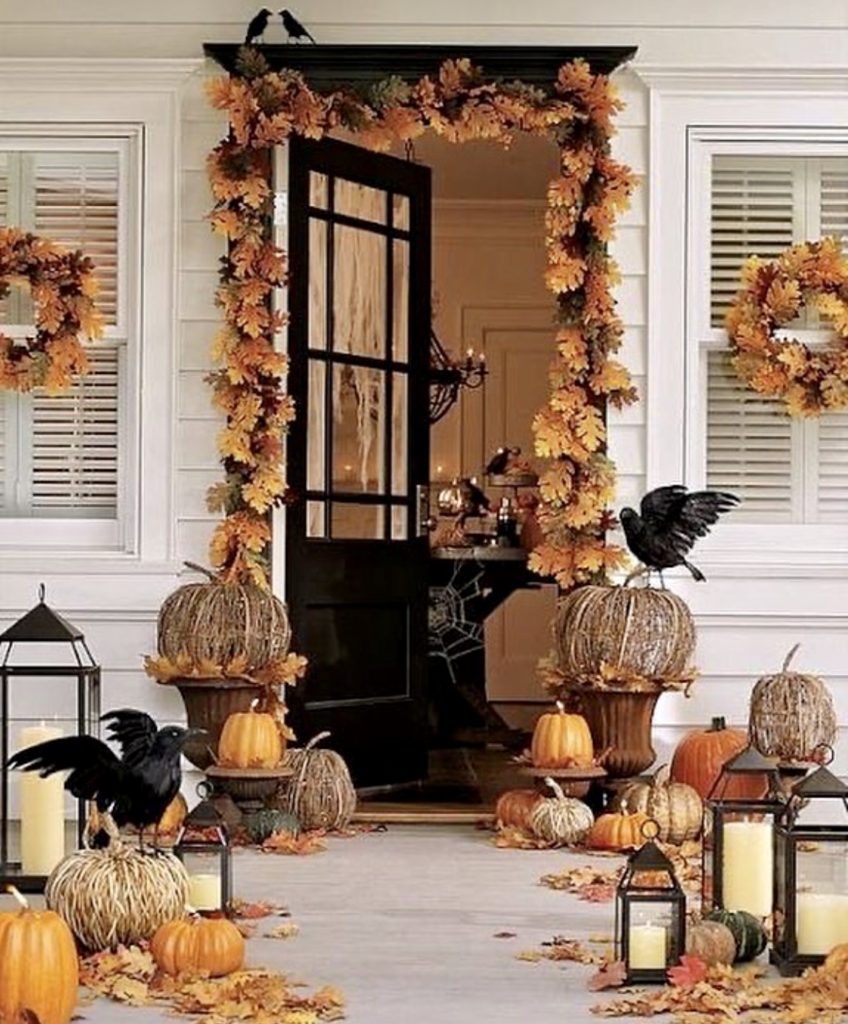
Photo courtesy of @pro.fessorpumpkin. It’s that time of year. We start thinking about cooler weather, sweaters and scarves, and pumpkin spice lattes. We may begin daydreaming about pumpkin patches, apple orchards, and hayrides. It is also time when we begin imagining how we will decorate for fall. One of the most popular places to decorate for the season is your front porch or entryway.
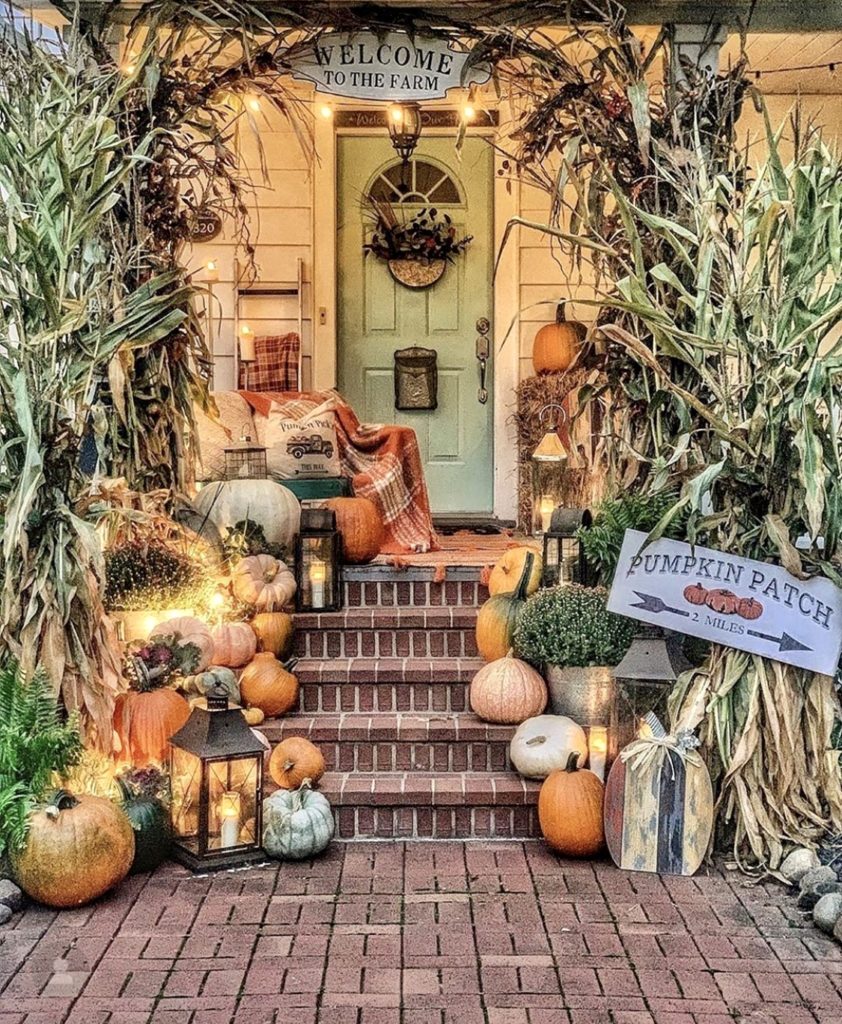
Photo courtesy of @ourblissfulcottage. Nothing says autumn like a festive, decorated porch. Whether you hope to create beauty with quintessential potted chrysanthemums and pumpkins, or a spooky vibe with skeletons, the following fall decorated porches will inspire you.
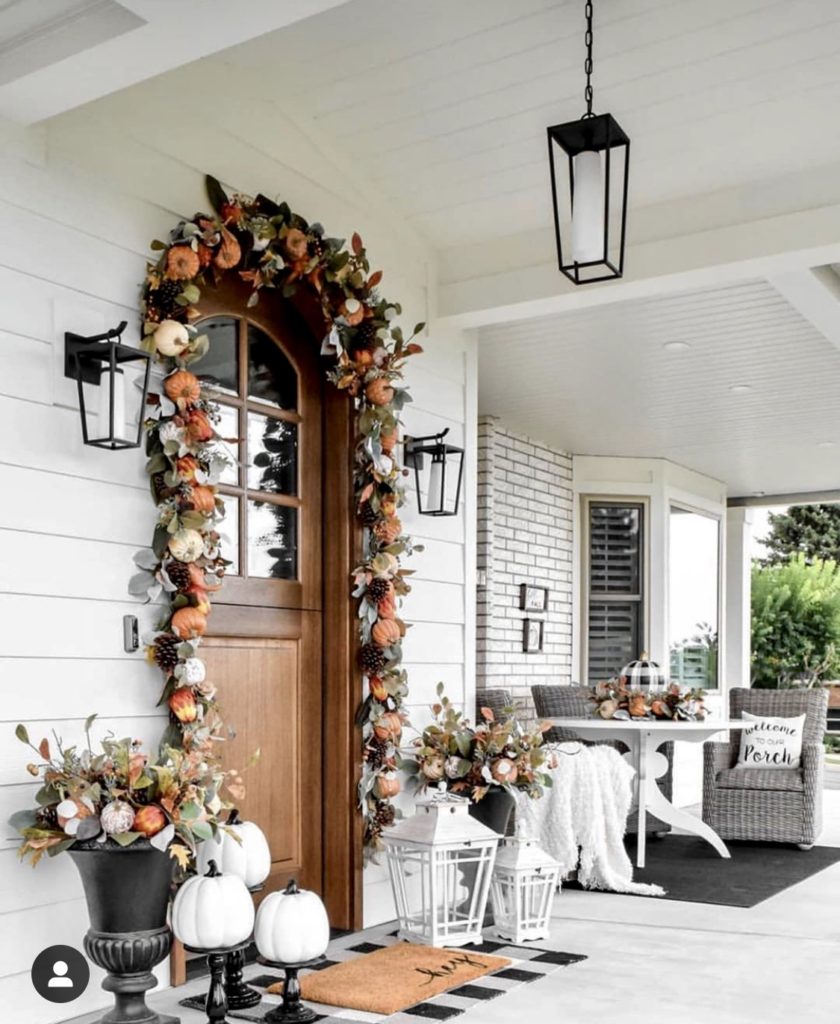
Photo courtesy of @thefarmhousepages. 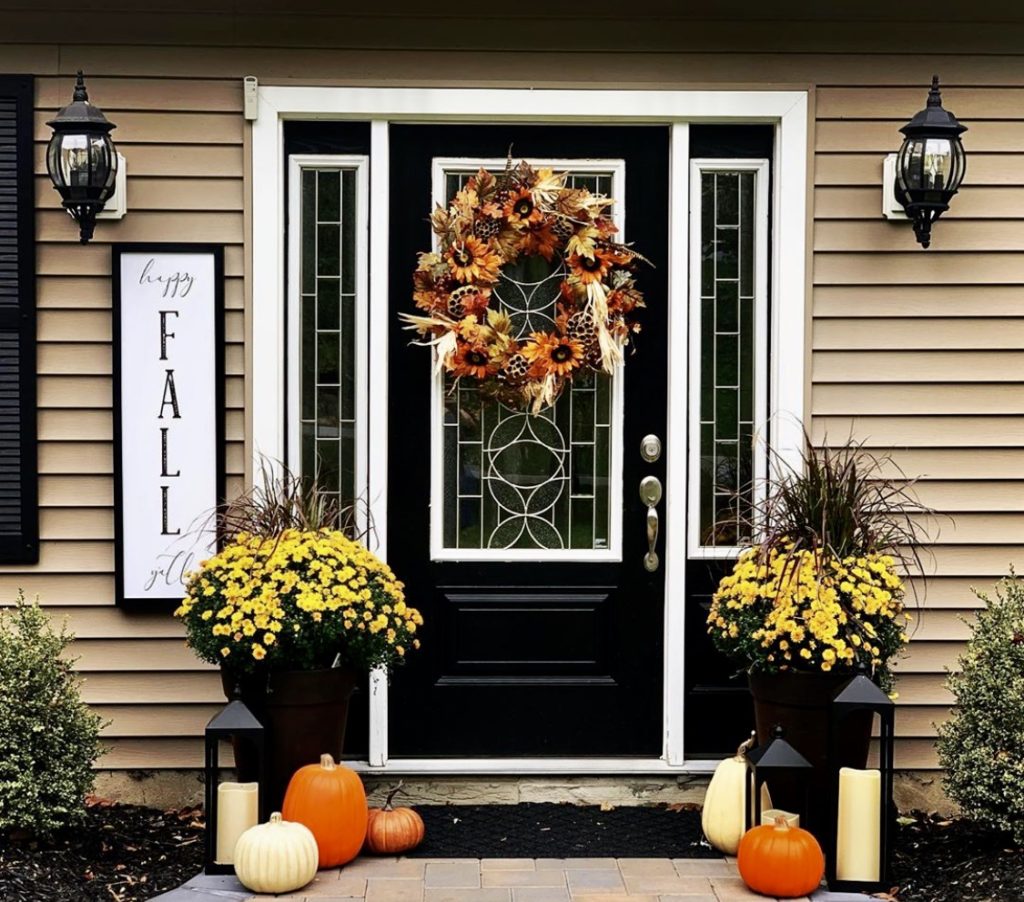
Photo courtesy of @tpederson627. A beautiful fall themed porch is guaranteed to impress friends and family. Some of the most popular fall decor for front porches includes wreaths, bushel baskets, pumpkins, lanterns, cornstalks, and potted plants and flowers.
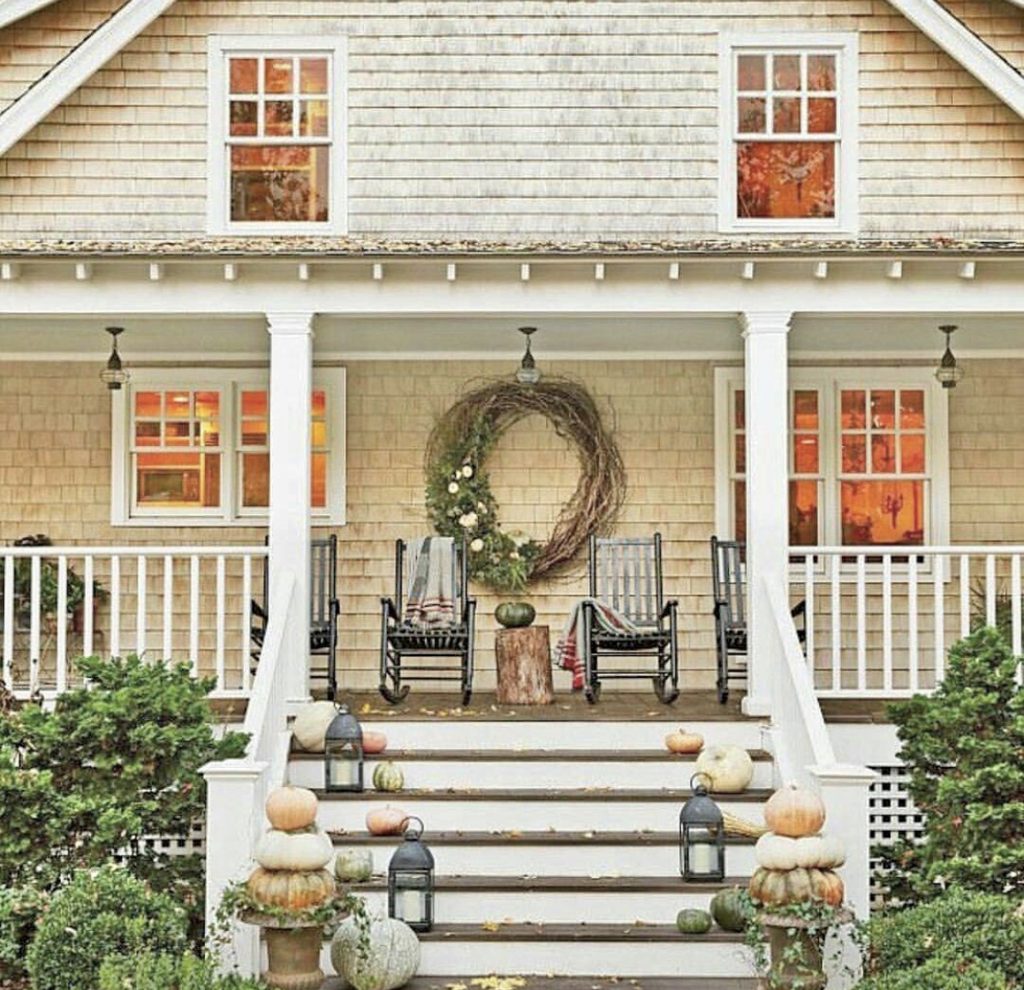
Photo courtesy of @vintagehearthome. Those fortunate enough to have large porches often use comfortable furniture such as benches, rocking chairs and porch swings cozied up with throw pillows and afghans. I love the simple rockers here in front of the over-sized wreath.
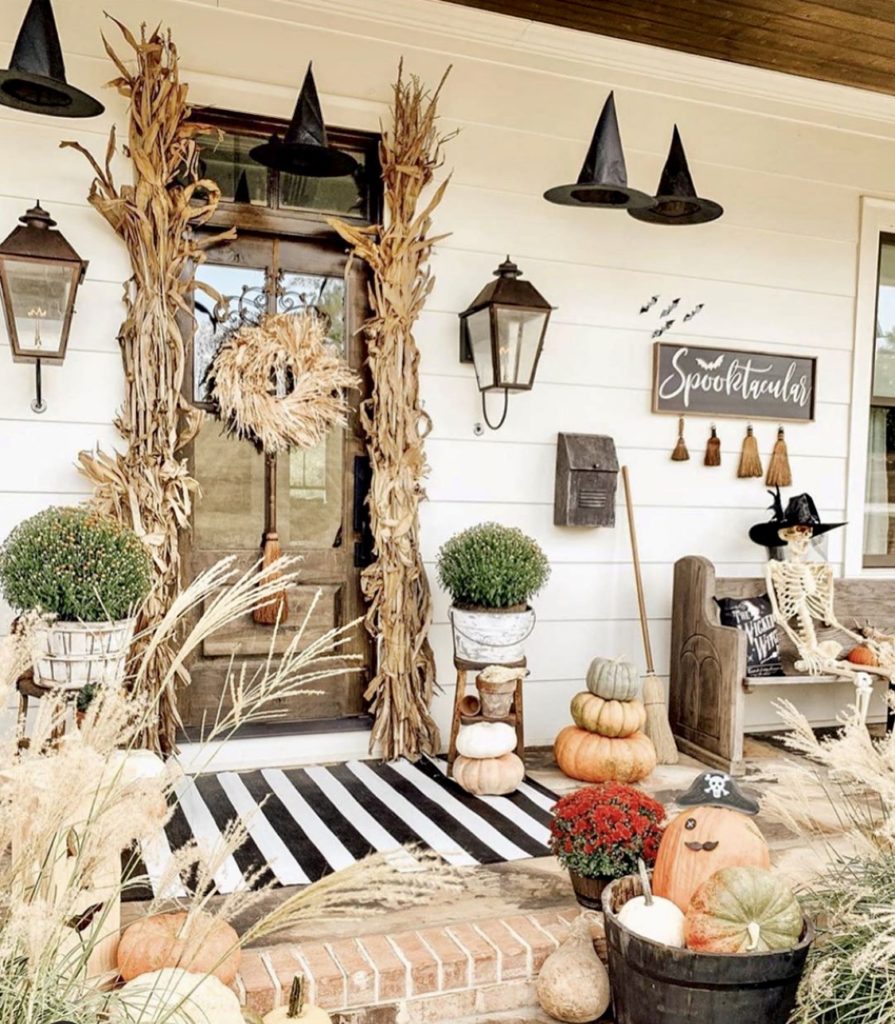
Photo courtesy of @farmhousefeatures. Brooms, skeletons, signs, and witches hats are also used to create a spooky fall vibe. I am a big fan of graphic floor rugs such as the one above to add additional porch flair.
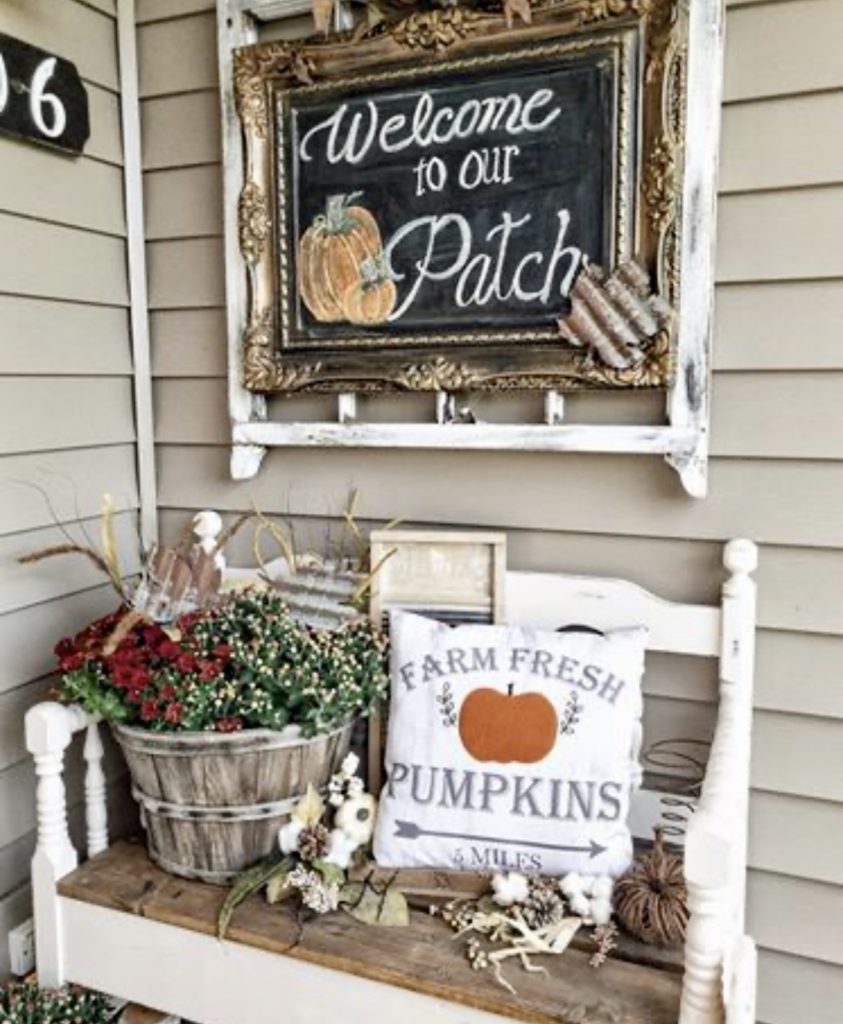
Photo courtesy of @thewillowwindow. Baskets and burlap banners, garlands, gourds and chalkboards also add autumn ambiance. I love the antique framed chalkboard above the cozy farmhouse bench here.
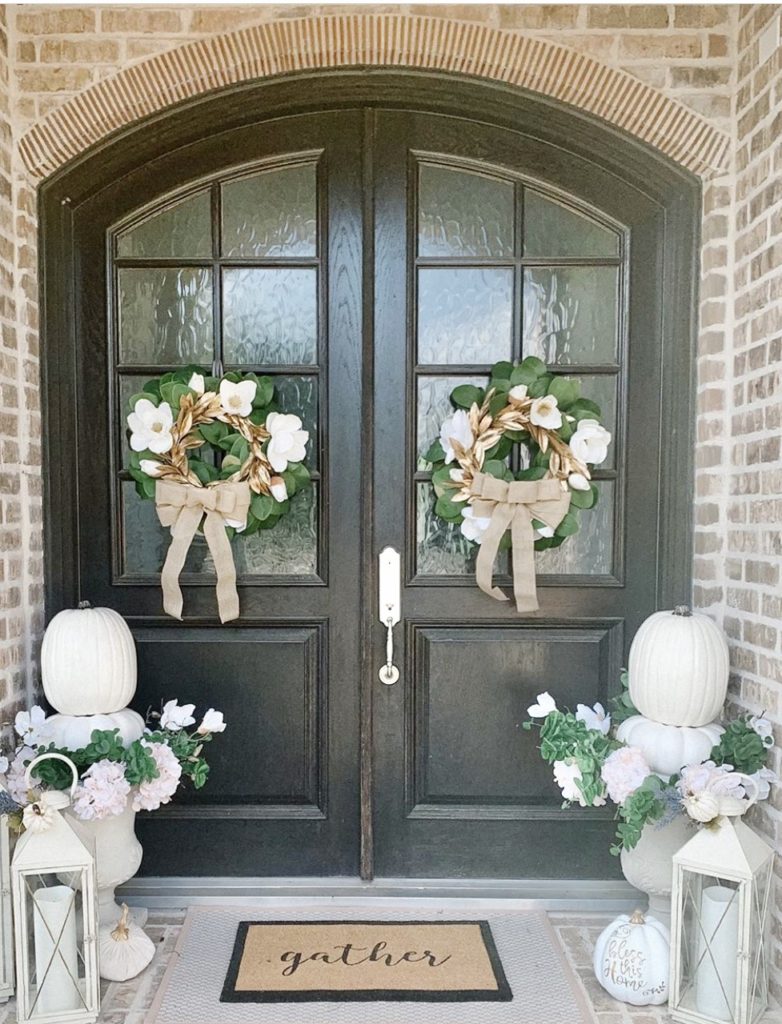
Photo courtesy of @shannongolddesign. If you don’t like classic fall colors like orange and brown, use neutrals like @shannongolddesign did above. White offers a fresh, elegant feel.
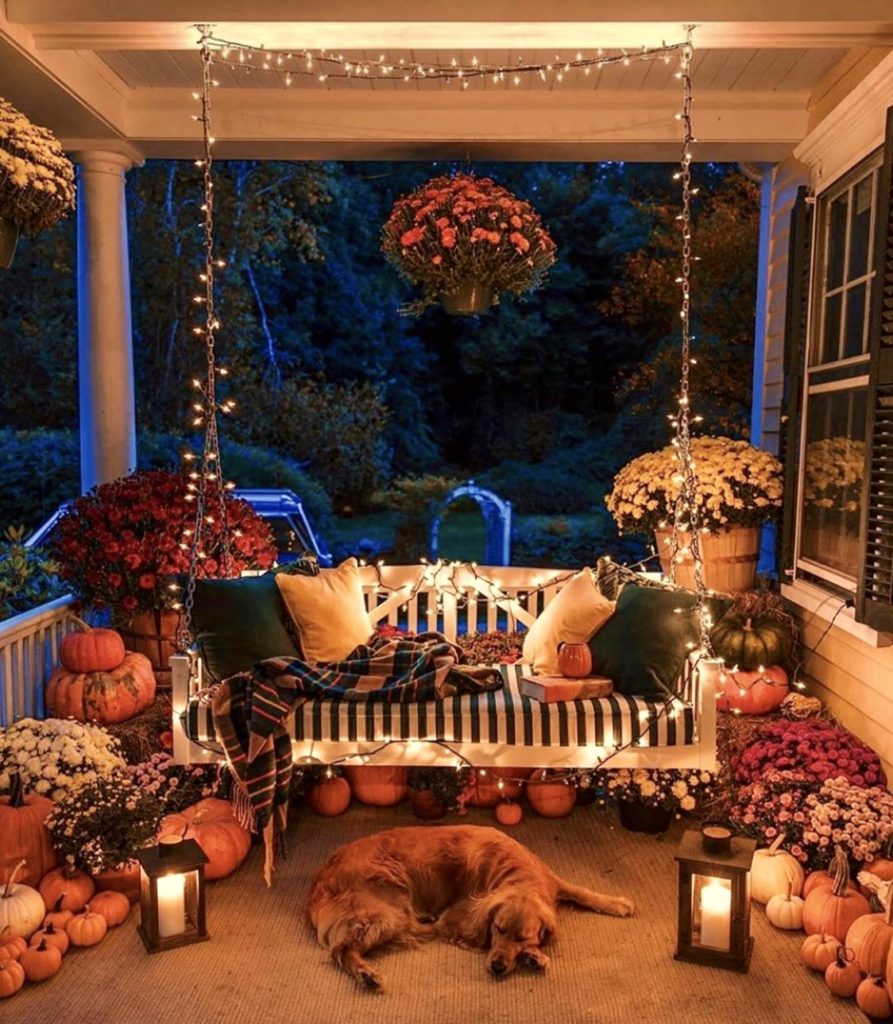
Photo courtesy of @the_aesthetic_side_of_homes. Don’t forget setting the tone for evening. Mood lighting including string lights and the soft flicker of battery operated candles inside lanterns creates a comfortable and inviting setting here.

Photo courtesy of @farmkitchencandleco. The use of symmetry helps balance this small area while providing a stunning display.
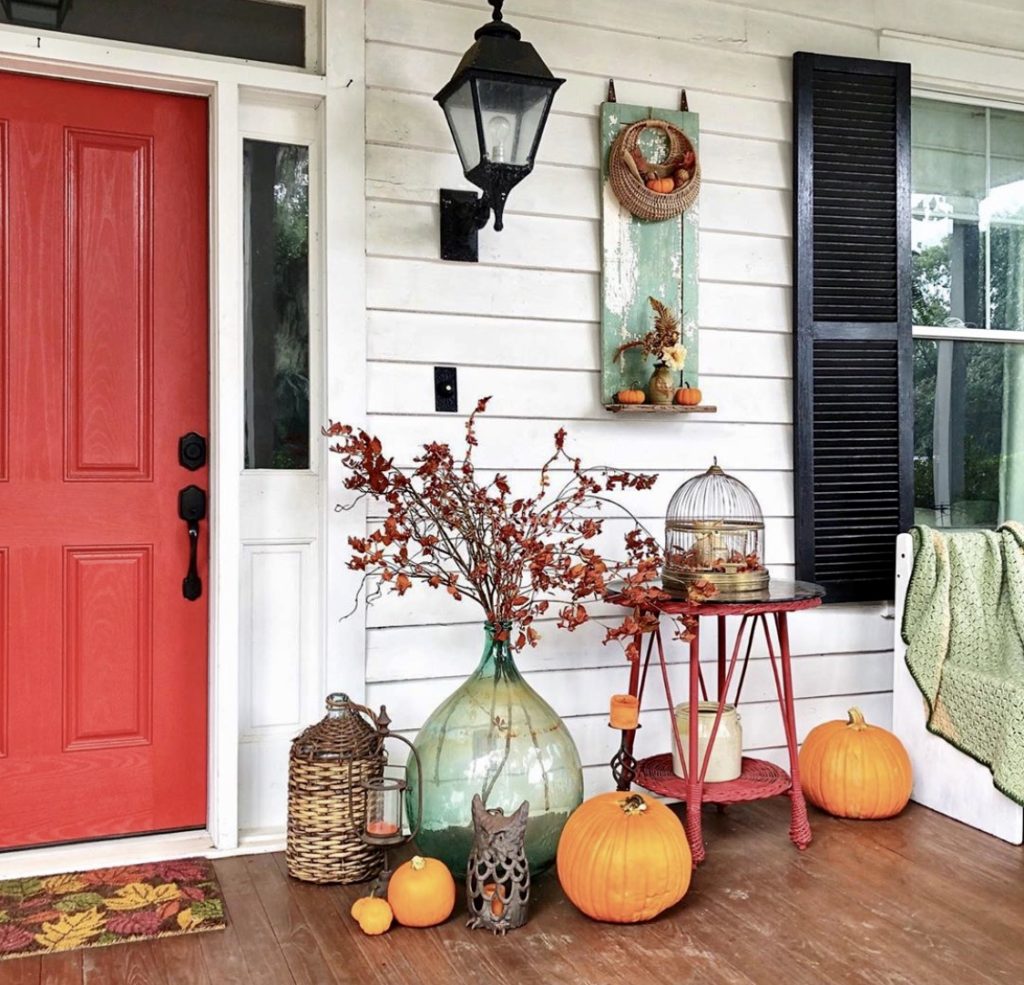
Photo courtesy of @our1880southerncottage. If you don’t feel like breaking the bank to get a fun fall look on your porch, consider using what you have. Gather branches of colorful leaves from your backyard and place in a vase, or use baskets, birdcages or more filled with dried flowers and gourds for a festive feel.

Photo courtesy of @keeleymckendree. Thank you for visiting my blog! I hope you found some fun and fabulous fall porch inspiration. You may also enjoy my other post Eight Fall Fun Activities in Monterey County.
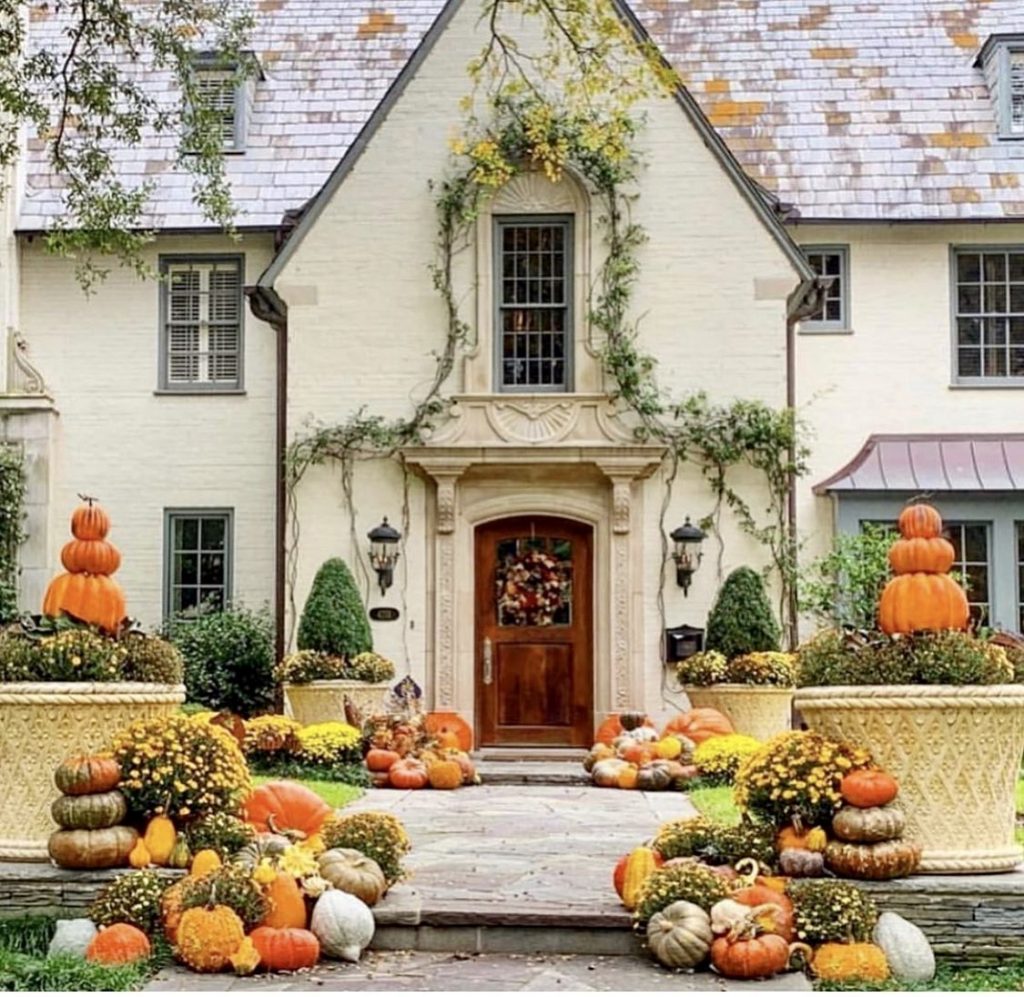
Photo courtesy of @southernlivingmag. Wishing you peace, love, happiness, & beautiful vistas!
-
The Quirky Creativity of Pacific Grove, California
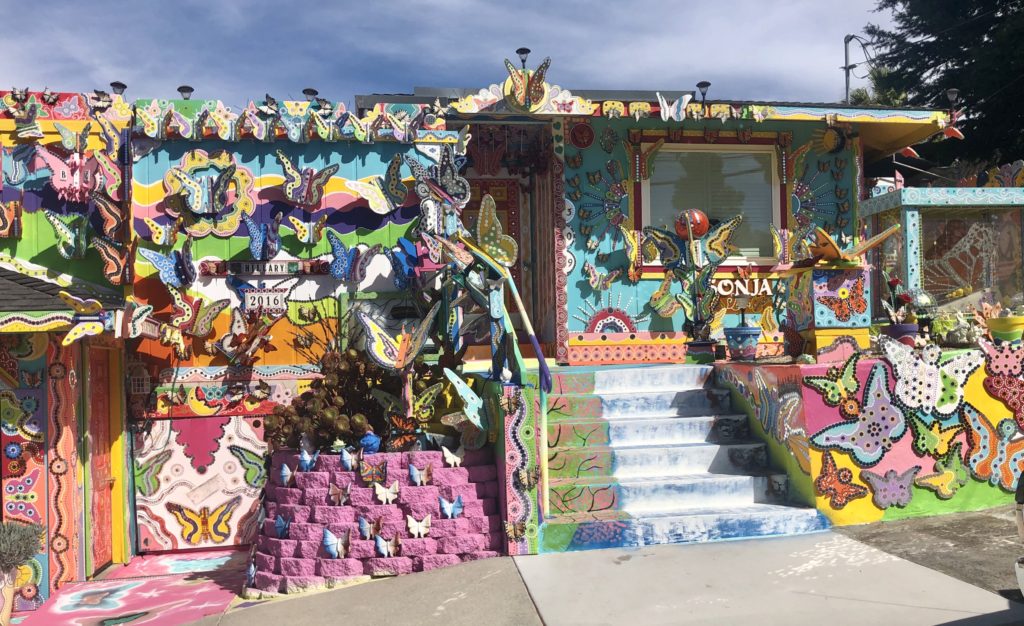
Someone really loves butterflies here in Pacific Grove, also known as Butterfly Town. Merriam Webster defines quirky as “unusual in especially an interesting or appealing way”. Synonyms for quirky include bizarre, curious, eclectic, kooky, peculiar, remarkable, and eccentric. In my opinion, every one of these boxes can be checked for Pacific Grove, also known as PG. While most of PG is full of traditional historic homes and businesses, it is the unusual features that often catch my eye. I find these quirky qualities oddly appealing.
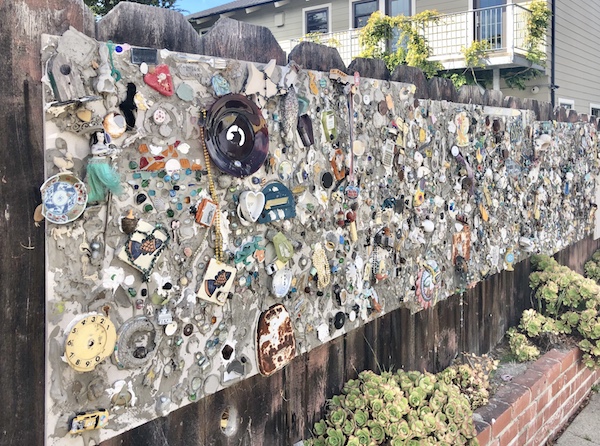
Maybe it’s my British genes (aren’t they prone to eccentricity?), or just my appreciation for people who think creatively, but I love turning a corner to find something novel and bizarre. This mosaic wall in PG features such things as a hula doll, an old clock, a hot wheels car, and pearl necklaces in its composition. I love it.
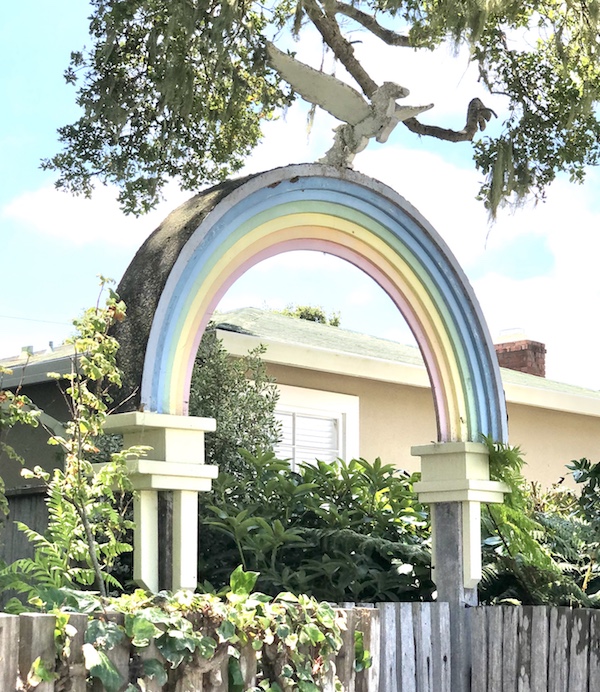
Why have an ordinary garden arbor when you can have a rainbow with Pegasus flying over it? Horace Walpole, an English author, coined the word “serendipity” during the 1700s. Serendipity was used to describe making fortunate discoveries by accident. He based his new word on a fairy tale in which the three princes of Serendip were always making discoveries during their travels by accident. I would certainly call my accidental discoveries serendipitous.
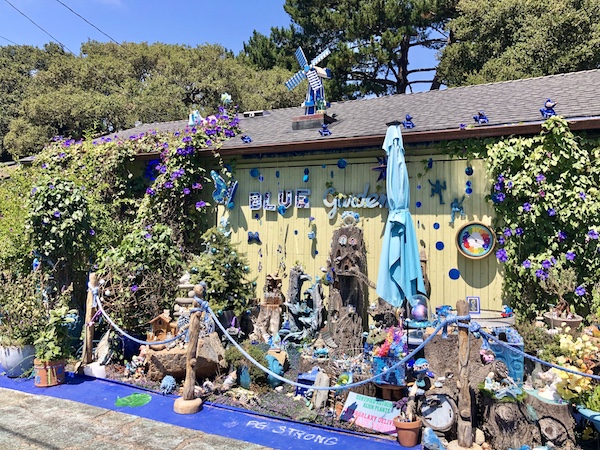
The “Blue Garden” above, was discovered in an abandoned alley. It features morning glories, a windmill on the roof, a mechanical roaring dinosaur, a unicorn balloon, a waterfall fountain, and carnival music, among other things.
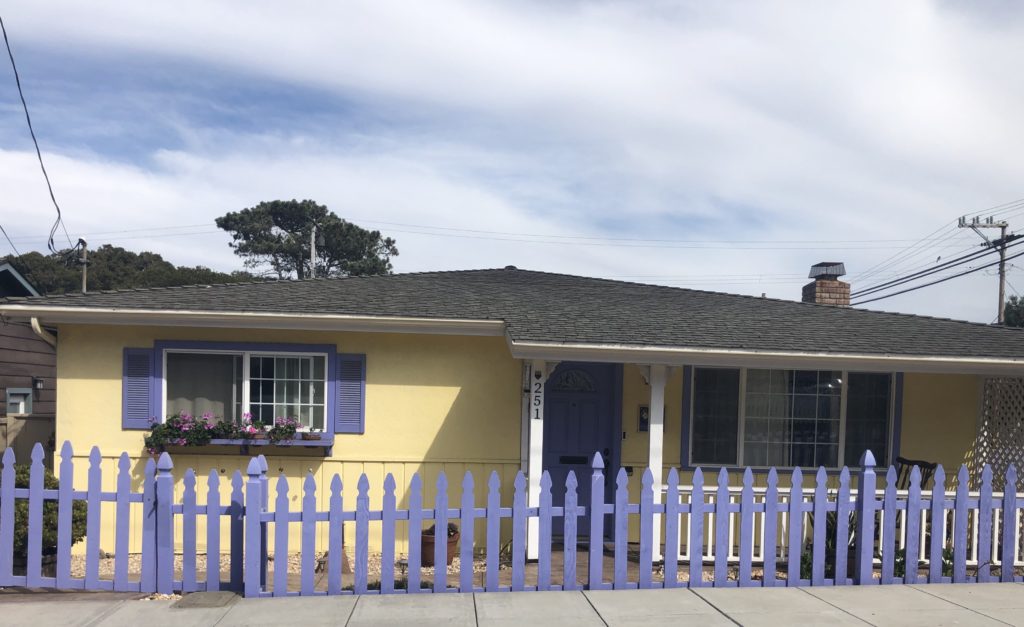
What I find so refreshing about Pacific Grove is that people are allowed to be who they are here. Personal expression is embraced. Nobody seems to care if you want to paint your picket fence purple or have dozens of kooky little gnome statues stacked on your porch. It’s truly an accepting culture. Several of my friends live here and they absolutely love it.

Photo courtesy of @thescenicshutter Quirkiness is also found in some of the unique shops here. Tessuti Zoo, located at 171 Forest Avenue, has been described as “the most colorful, zany, eclectic store one may ever shop”.
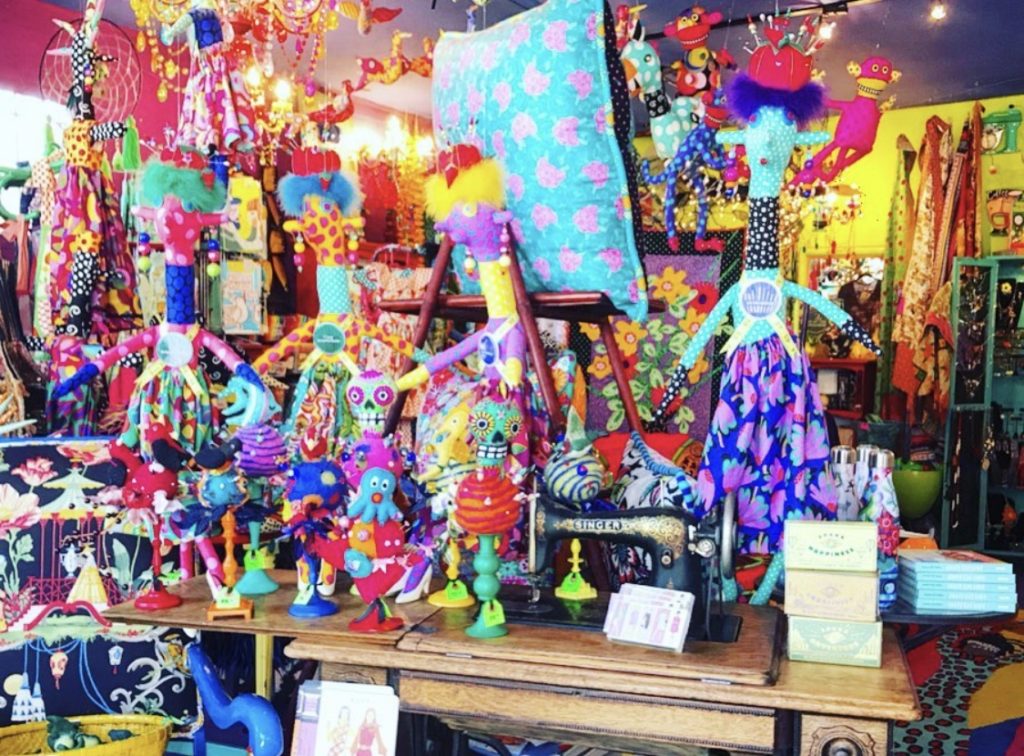
Photo courtesy of @ca.love.fornia For more information, see Pacific Grove. You may also enjoy my other posts: Butterfly Town: Pacific Grove, Lovers Point: Legendary Park in Pacific Grove, Point Pinos Lighthouse, Pacific Grove, The Feast of Lanterns in Pacific Grove, and Picket Fences by the Seaside: Victorian Homes in PG.
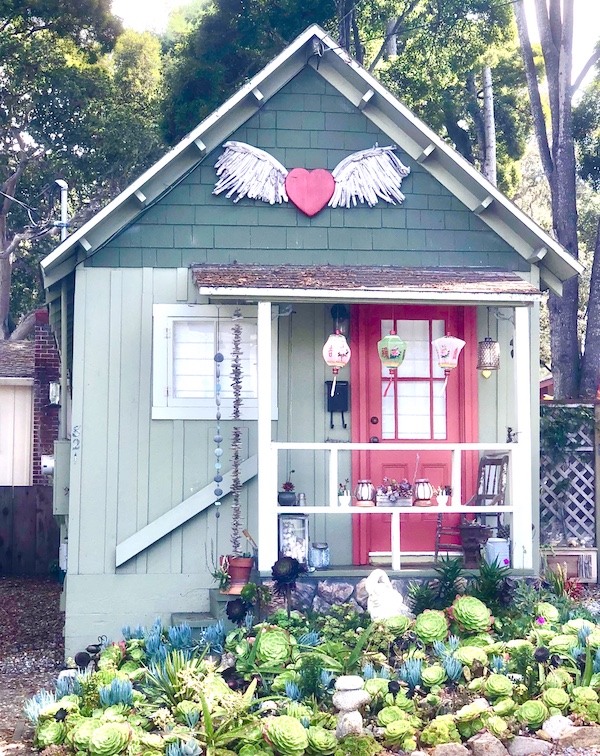
Thank you for visiting my blog! Wishing you peace, love, happiness, and beautiful vistas.
-
The Allure of Vintage Tea Cups
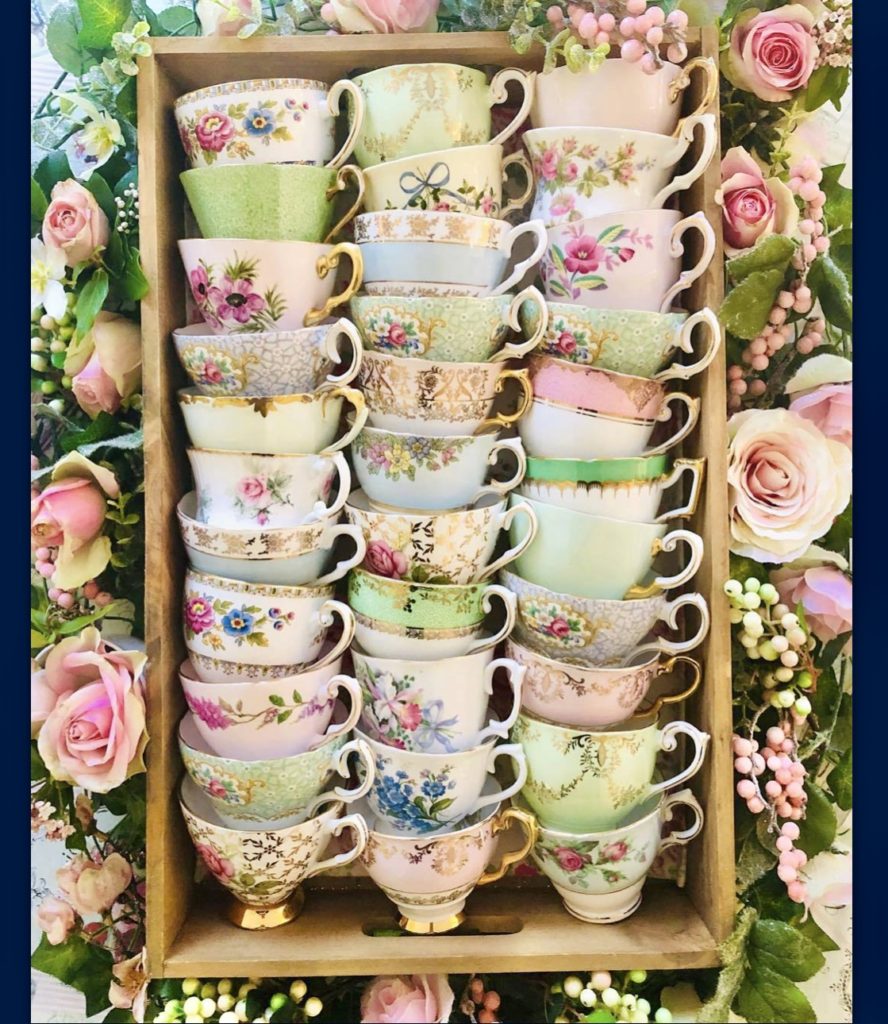
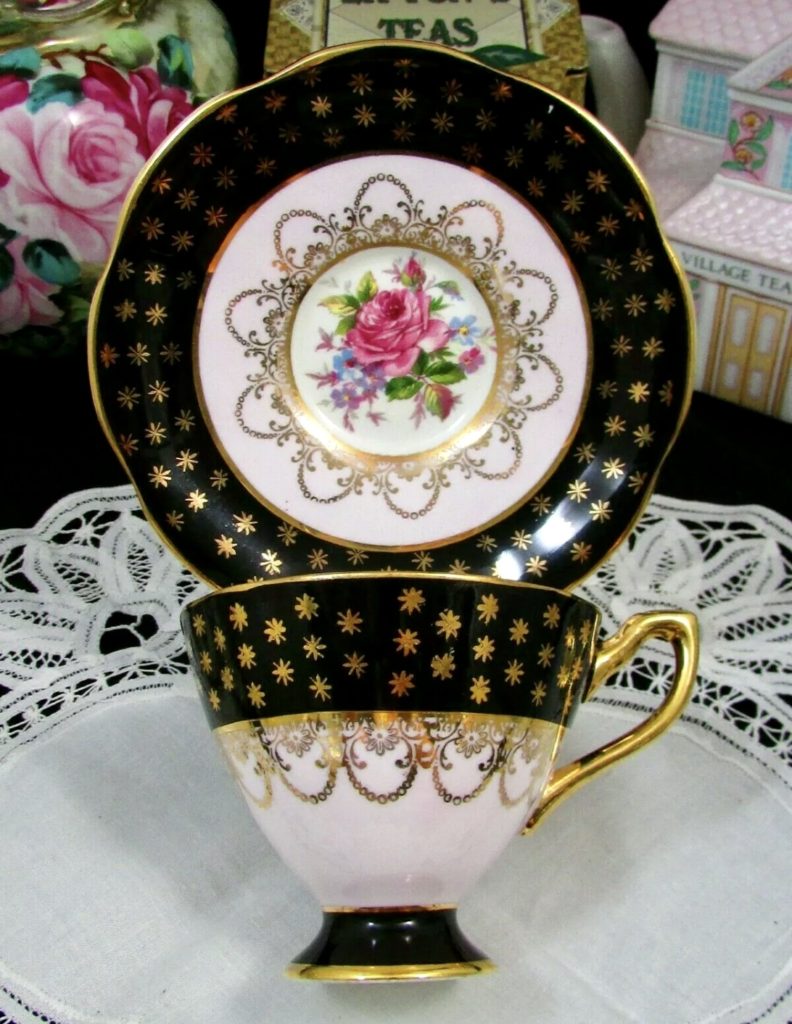
Lovely vintage Queen’s tea cup and saucer. People have been using and collecting tea cups for years and years. Because they are often beautiful as well as functional, vintage tea cups are a popular collectible. And while some rare and fancy tea cups can go for thousands of dollars, many vintage ones can be found for very reasonable prices.

Early tea cups were handleless and called tea bowls. These pretty blue and white porcelain bowls were exported from the Far East to Europe. In 1707, a German alchemist and inventor named Johann Friedrich Bottger designed the first European porcelain that could rival the Chinese porcelain. While handleless bowls are still traditional in many Asian countries, it is somewhat of a controversy as to why handles were added to British tea cups. Some opinions state that it was because the British liked their tea “piping” hot and didn’t want to burn their hands, and others indicate it was merely a design invention to improve on the often clumsy and messy tea bowls. Notwithstanding the reason for their invention, handles began to appear on many tea cups by the early 1800s.
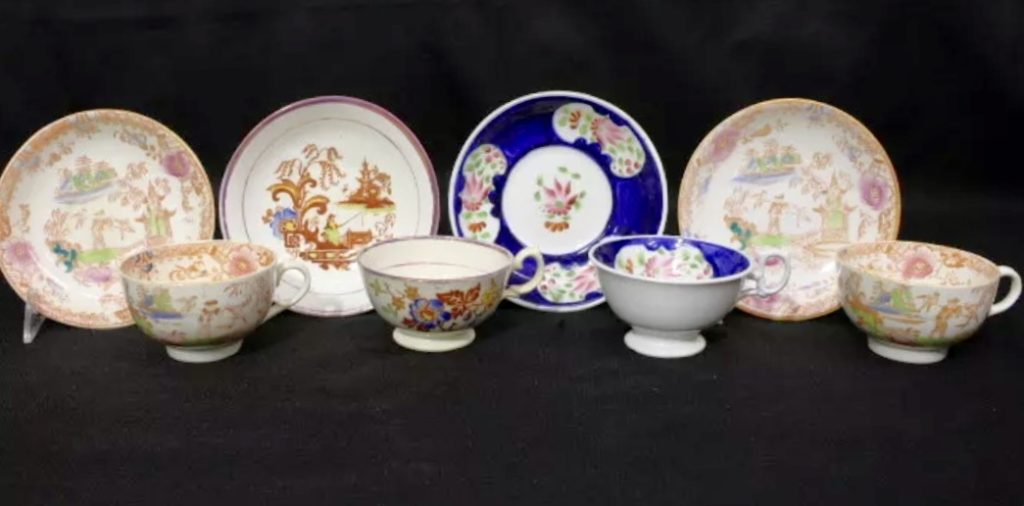
A variety of teacups and saucers from the mid-1800s. During the peak of the British Empire, from 1800-1830, elegant cup and saucer sets began to be produced to meet popular demand. Later, in the Victorian era, cups and saucers were often given as gifts by affluent ladies for various social occasions.

This vintage cup & saucer by Paragon was designed to be given to a bride. Writer Diana Cass relates the decorum for a “Teacup Bridal Shower” held for one of her relatives during the 1940s. “Each guest is to bring a wrapped teacup and saucer. Presented with them will be a word that represents the characteristics one should have to achieve a happy marriage. words like : patience, cooperation, music, unselfishness, humor, etc. The word should be tucked into the teacup and read aloud as the gift is opened.”

My small but growing tea cup collection. Most vintage tea cups are made from either porcelain or bone china and feature a flat or pedestal bottom. Beautiful designs were made well into the 1950s. The patterns and designs are myriad, and this is probably what makes collecting tea cups so enjoyable for many people. Whether you have received hand-me-downs from your Grandmother or found one at a local yard sale, vintage tea cups can be addicting.
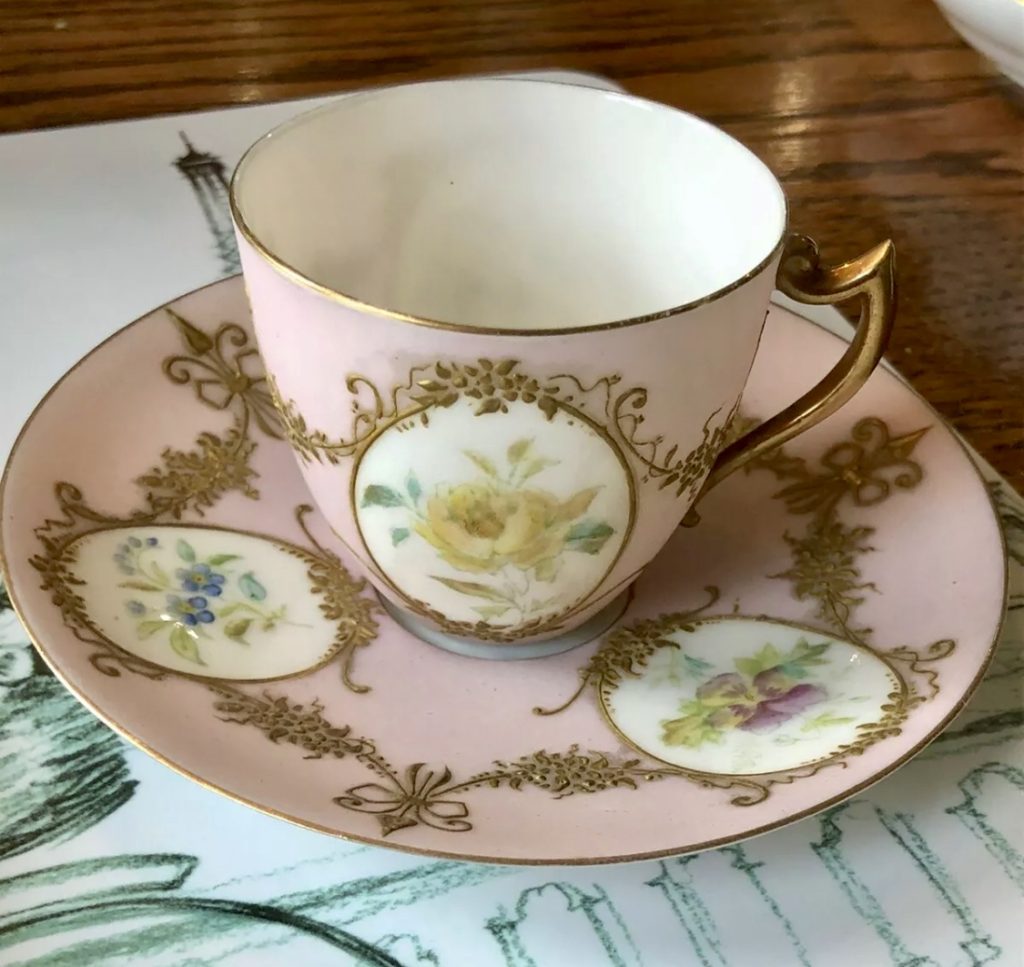
A demitasse cup and saucer. Some people enjoy collecting smaller sized demitasse cup and saucers. These diminutive cups almost appear child-sized, but are actually designed for espresso or coffee, often after a meal. Demitasse is a French word meaning literally “half-cup”.
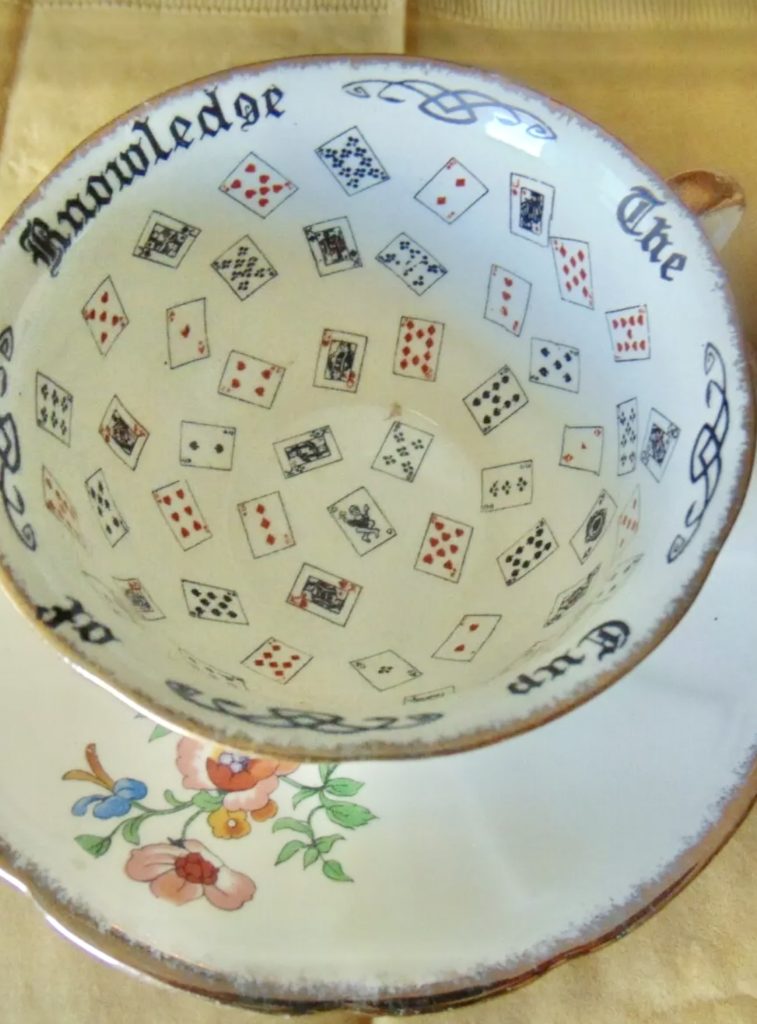
A vintage fortune-telling tea cup and saucer. There are a variety of novelty vintage tea cups. Some were made for fortune telling, which involves reading the patterns created by tea leaves once a cup has been emptied by a tea drinker and making predictions. Sometimes these even included special instructions. Other novelty tea cups celebrate specific events, such as coronations, or feature months of the year with corresponding flowers.
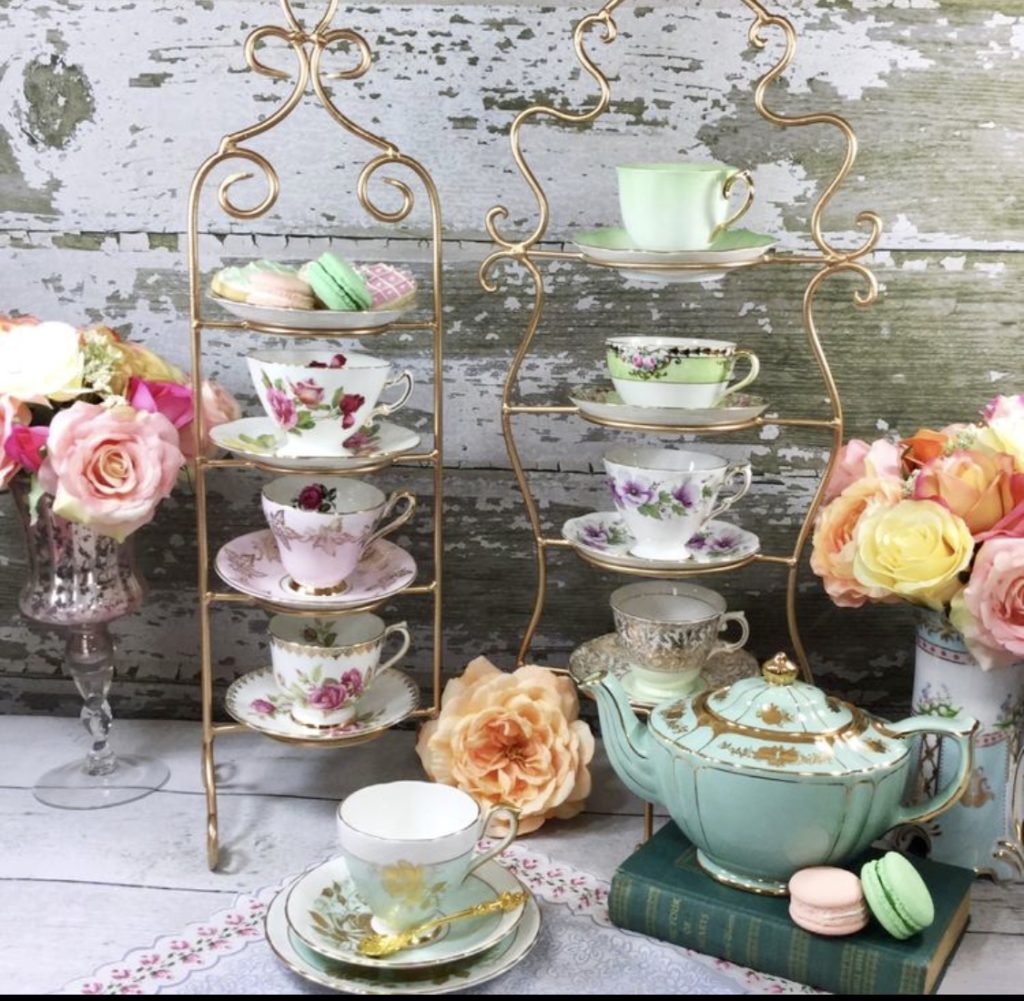
Some people like to collect only specific colors or shapes, or they prefer tea cups from a specific country, maker, or time period. English and French made tea cups seem to be the most interesting to me, but you can also find beautiful vintage ones from Japan, China, Germany, and other countries as well. Some of the most popular manufacturers are Paragon, Limoges, Royal Albert, Aynsley, Shelley, Royal Doulton, and Royal Worcester.

This vintage tea cup made by Paragon features a flower handle. You can find vintage tea cups at thrift stores, rummage sales, antique shops, flea markets and antique shows or online at places such as eBay and Etsy. For more information, see The Story of Tea: A Cultural History and Drinking Guide, by Mary Lou and Robert J. Heiss or check out Teacups 101. You may also enjoy my post The Tuck Box: A Fairy Tale Tea Room in Carmel-by-the-Sea.
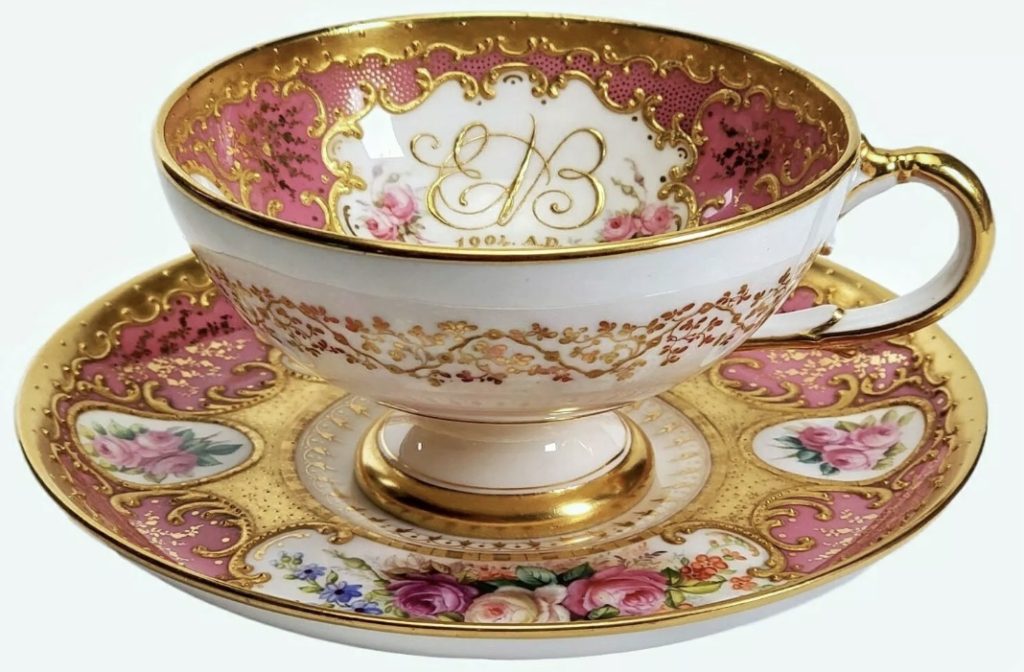
This very fancy hand painted tea cup and saucer was made by Royal Worcester in 1904. Thank you for visiting my blog. Wishing you peace, love, happiness, and beautiful vistas!
-
The History of Romantic Dovecotes
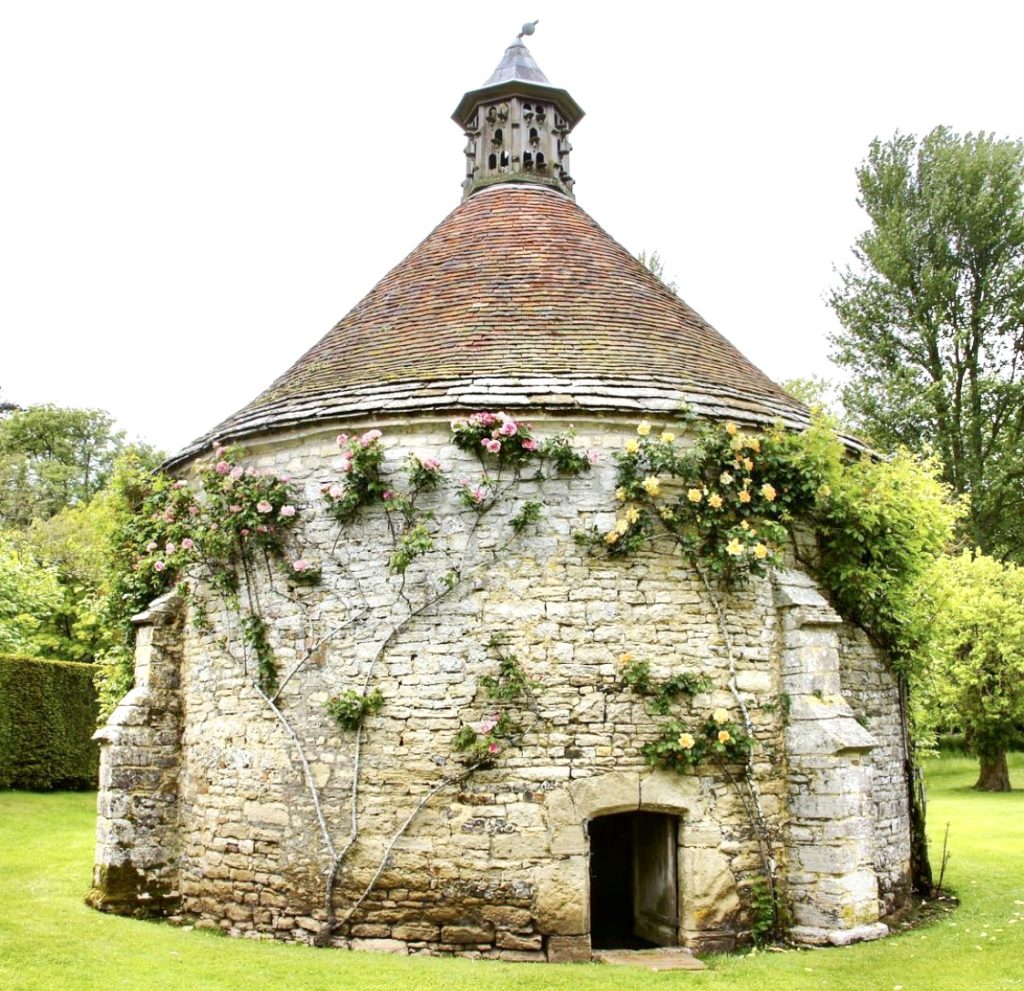
Very old dovecote at Athelhampton House & Gardens in Dorchester, England. Dovecotes have always seemed very romantic to me. My first exposure to the concept of dovecotes was when I read Louisa May Alcott’s Little Women. In the novel, the eldest of four sisters, Meg March, becomes engaged. Her fiancé, John Brooke, builds a tiny cottage for them to live in once they are married. The March’s dear neighbor Laurie christens it the “Dovecote”, insisting that “it was highly appropriate to the gentle lovers who went on together like a pair of turtledoves”.
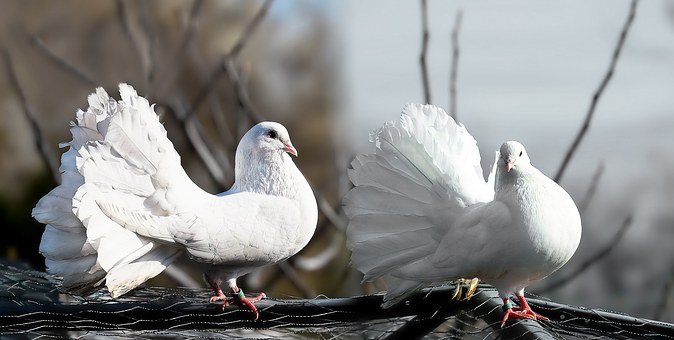
Unfortunately, my romantic notion of dovecotes burst when I did more research. Apparently, most dovecotes were used to house blue rock pigeons, an important food staple. This practice skyrocketed during medieval times. According to Peter and Jean Hansell in their book Dovecotes, “the cost of the birds’ upkeep was negligible because they foraged far and wide…and needed supplementary feeding only when snow was on the ground”. In addition, the Hansells relate that pigeons are highly prolific and “an unfailing supply of squabs could be relied upon” for meals. Pigeons were also kept for their eggs, droppings, and feathers. Pigeon droppings were used for leather tanning and making gunpowder. Their feathers were used for pillows and feather beds. Pigeons also often served medicinal purposes, however, I will refrain from relating the details as it is a bit gruesome.
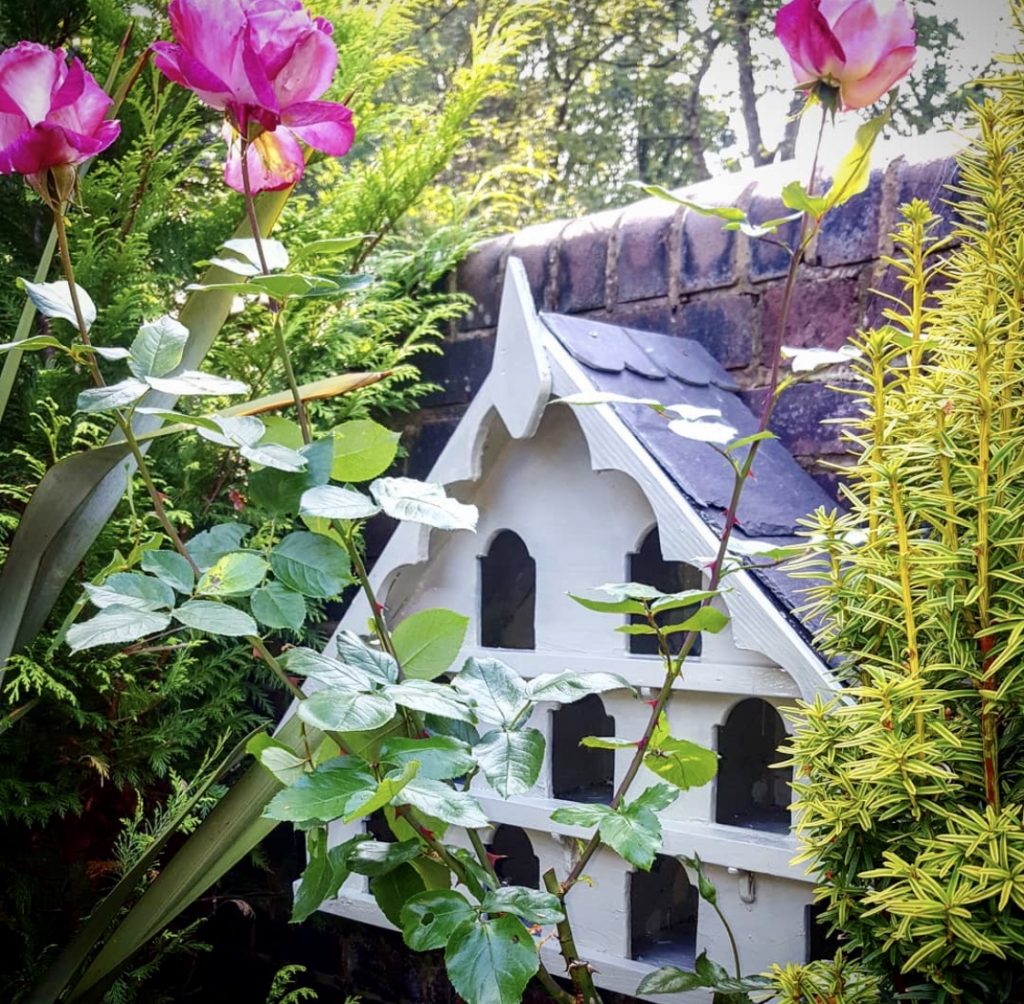
Photo courtesy of @xsharon.s I am happy to report that these once common practices have all but died out today, although certainly not entirely. And just like those biblical heroes of old, the dovecote dwelling blue rock pigeons have left numerous descendants. They begat and begat and begat. Those descendants include both feral pigeons inhabiting cities and parks and the pretty white doves often portrayed carrying olive branches, hence both “dove” and “pigeon” are used interchangeably. Did you know that another word for dovecote is pigeonaire? I prefer dovecote, pigeonaire sounds somewhat like an old appliance to me.

Dovecotes were built in many styles, including circular, square and rectangular, and octagonal. Per the Hansells, early dovecotes were generally made of mud, clay, straw, wattle and daub, limestone, sandstone, flint, chalk, timber framing, weatherboarding, granite, and slate, and later dovecotes were made of brick and stone. While early structures were free-standing and limited to very wealthy people such as lords with manors or castles, or large monasteries, later dovecotes were often much smaller and built into the side of homes and barns.
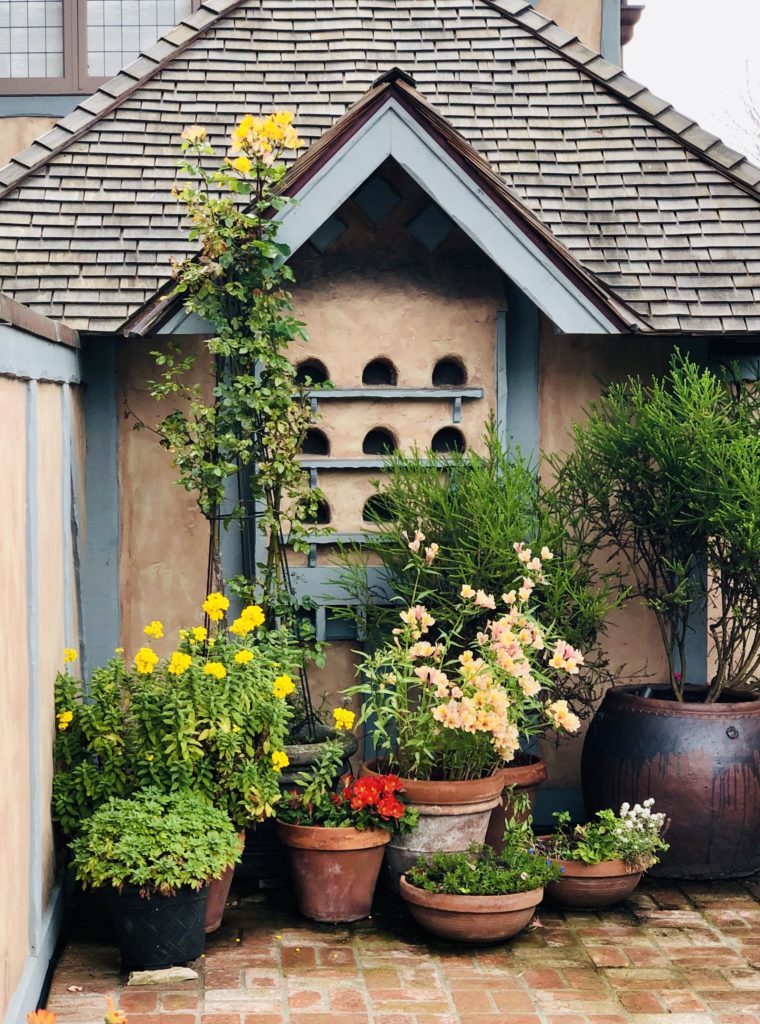
Dovecote in Carmel-by-the-Sea. While the history of dovecotes was not necessarily what I had envisioned, I still find these structures enchanting. I also find it endearing that people are still using dovecotes today to provide shelter for our feathered friends.
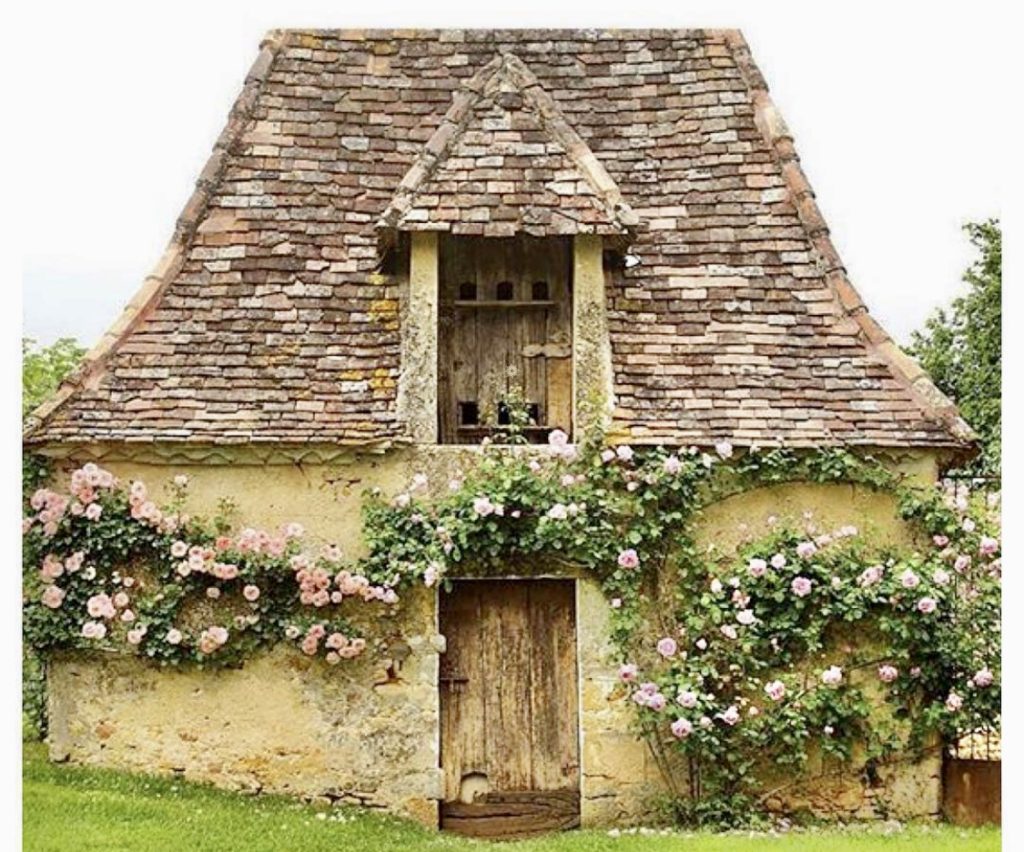
French dovecote photo courtesy of @serendipity_loves For more information on dovecotes, see the following by Peter and Jean Hansel: Dovecotes, Doves and Dovecotes, and A Dovecote Heritage or visit Pigeon Cote. You may also enjoy my post Add Charm to your Garden with Beautiful Birdhouses!
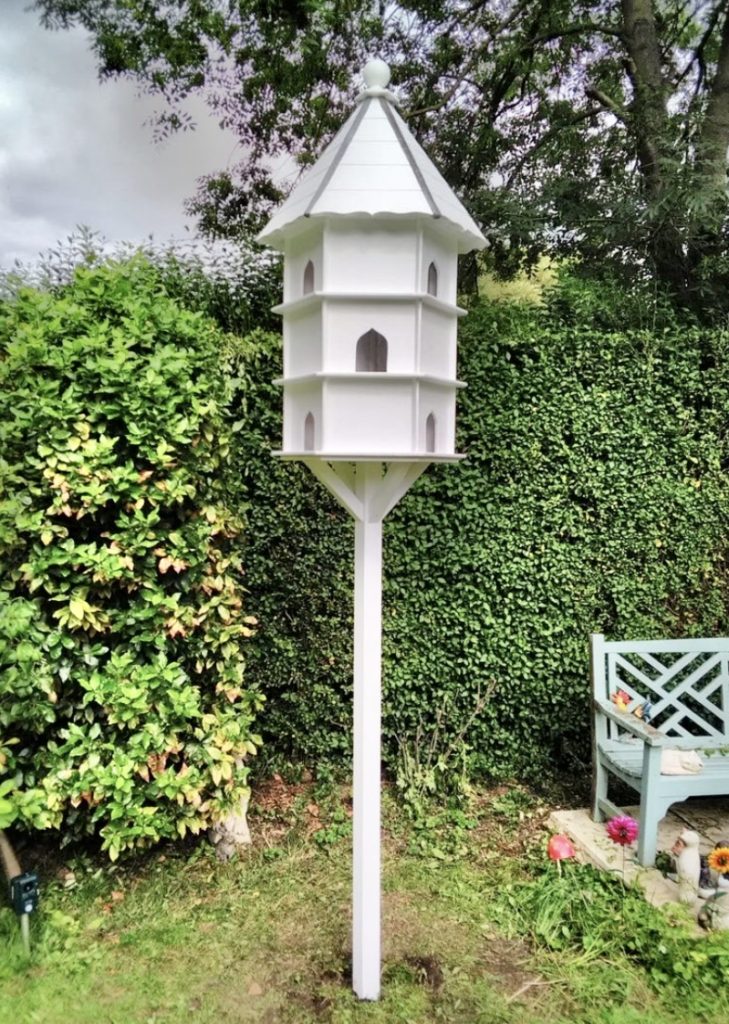
Hand-made Bespoke dovecote available on Etsy.com Thank you for visiting my blog! Wishing you peace, love, happiness, and beautiful vistas.